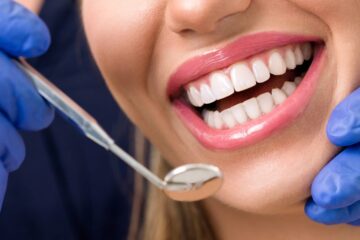Are you ready to unlock the secrets to a healthier smile? Look no further than ‘The Ultimate Guide to How to Floss.’
In this comprehensive article, we’ll arm you with the knowledge and techniques to take your oral care routine to the next level. Discover the importance of flossing for your overall dental health, debunk common myths, and learn how to choose the ideal dental floss.
Get ready to integrate flossing into your daily routine and achieve a radiant, cavity-free smile.
The Importance of Flossing for Oral Health
You should know that flossing daily is crucial for maintaining optimal oral health. Flossing helps remove plaque and food particles that your toothbrush can’t reach, preventing the buildup of bacteria in your mouth.
The benefits of flossing regularly are numerous. Firstly, it helps prevent tooth decay by removing the plaque that can lead to cavities. Secondly, flossing reduces the risk of gum disease, as it removes the bacteria that can cause inflammation and infection in the gums. By flossing, you also improve the overall health of your mouth, reducing bad breath and preventing tartar buildup.
On the other hand, not flossing regularly can have serious consequences for your oral health. The plaque and bacteria that accumulate between your teeth can lead to tooth decay, gum disease, and even tooth loss. Additionally, the inflammation caused by gum disease can increase the risk of other health conditions, such as heart disease and diabetes.
Therefore, it’s important to make flossing a part of your daily oral hygiene routine to enjoy the benefits and avoid the consequences of neglecting this simple yet essential habit.
Step-by-Step Guide to Proper Flossing Technique
To properly floss your teeth, begin by cutting a piece of dental floss about 18 inches long. This length allows for a fresh section of floss to be used for each tooth. Next, wrap the ends of the floss around your middle fingers, leaving about 2 inches of floss in between. Hold the floss tightly between your thumbs and index fingers. Gently slide the floss between your teeth using a back-and-forth motion. Be careful not to snap the floss into your gums, as this can cause irritation. Curve the floss around each tooth, making sure to go beneath the gumline. Move the floss up and down several times to remove any plaque or food particles. Repeat this process for each tooth, using a clean section of floss each time.
Proper flossing tools, such as dental floss or interdental brushes, are essential for maintaining good oral hygiene. Flossing helps remove plaque and bacteria from areas that your toothbrush can’t reach, such as between your teeth and along the gumline. By flossing regularly, you can prevent gum disease, cavities, and bad breath.
Flossing also promotes healthier gums by stimulating blood circulation and reducing inflammation. Additionally, studies have shown that flossing can lower your risk of developing heart disease and other systemic conditions. So, take the time to floss your teeth properly every day and reap the long-term benefits of a healthy mouth.
Common Myths About Flossing Debunked
Don’t be fooled by the common myths surrounding flossing – it isn’t just an optional step in your oral hygiene routine. Flossing is an essential part of maintaining healthy teeth and gums. Let’s debunk some of the most prevalent myths about flossing.
Myth #1: Flossing isn’t effective. This is simply not true. Flossing is highly effective in removing plaque and food particles from between your teeth, which your toothbrush can’t reach. It helps prevent tooth decay, gum disease, and bad breath.
Myth #2: Alternatives to flossing are just as good. While there are alternative flossing methods available, such as water flossers or interdental brushes, they aren’t as effective as traditional flossing. These alternatives may be useful for individuals with braces or other dental appliances, but they shouldn’t replace regular flossing.
Myth #3: Flossing causes gum recession. This myth may have arisen from an incorrect flossing technique. When done properly, flossing doesn’t cause gum recession. It helps keep your gums healthy by removing plaque and preventing gum disease.
Tips for Choosing the Right Dental Floss
When selecting dental floss, consider the thickness and texture that best suits your teeth and gums. Choosing the right floss thickness is crucial for effective cleaning. For tight spaces between your teeth, opt for a thinner floss that can easily slide through without causing discomfort or gum irritation. On the other hand, if you have wider gaps or larger spaces, thicker floss may be more effective in removing plaque and food particles.
Texture is another important factor to consider. Waxed floss is smooth and glides easily between teeth, making it ideal for those with sensitive gums. It’s also less likely to shred or break. Unwaxed floss, on the other hand, is thinner and can be great for tight spaces. However, it may be more prone to shredding, so be gentle when using it.
If you have braces, it’s important to choose a floss specifically designed for braces. These flosses are typically thicker and have a stiff end that can be threaded underneath the wires to reach between the teeth. They’re also stronger to prevent breakage when used around the brackets and wires.
Now that you have selected the right dental floss for your needs, let’s move on to integrating flossing into your daily oral care routine.
Integrating Flossing Into Your Daily Oral Care Routine
Make sure you consistently and effectively floss your teeth every day, as it’s an essential step in maintaining good oral hygiene. Flossing not only helps remove plaque and food particles from between your teeth, but it also plays a crucial role in promoting overall health. By removing bacteria from your mouth, flossing can help prevent gum disease, which has been linked to various health issues such as heart disease and diabetes.
To encourage children to floss regularly, it’s important to make it a fun and interactive experience. Start by introducing flossing as soon as their teeth start touching each other. Use child-friendly floss picks or floss holders to make it easier for them to manoeuvre between their teeth. You can also make a game out of flossing by turning it into a family activity. Set a good example by flossing together and praising their efforts. Additionally, consider using floss that comes in different flavours or colours to make it more appealing to children.
Frequently Asked Questions
How Often Should I Floss My Teeth?
For optimal oral hygiene, flossing should be done once a day. It doesn’t matter which time of day you choose, as long as you do it consistently. Make sure to give each tooth proper attention.
Can I Use Any Type of Floss for Flossing?
You can’t just use any type of floss for flossing. The Ultimate Guide to How to Floss will explain the importance of using the right type of dental floss and alternative flossing tools.
Is Flossing Necessary if I Brush My Teeth Regularly?
Flossing is necessary even if you brush regularly because it helps remove plaque and debris from between your teeth and along the gumline. Different flossing techniques can make a difference in oral hygiene and prevent gum disease.
What Are the Benefits of Flossing Besides Oral Health?
Flossing not only benefits your oral health but also your overall wellness and systemic health. The Ultimate Guide to How to Floss provides detailed information on how flossing contributes to a healthier you.
Are There Any Alternatives to Traditional Flossing Methods?
Looking for alternatives to traditional flossing methods? Water flossers and interdental brushes are your go-to options. They provide efficient cleaning and reach those pesky gaps between your teeth. Say goodbye to excuses for not flossing!
Conclusion
Flossing is essential for optimal oral health. By following a proper technique, debunking common myths, and choosing the right dental floss, you can effectively remove plaque and prevent gum disease.
Make flossing a daily habit and integrate it into your oral care routine to maintain a healthy smile. Remember, flossing isn’t just for show, it’s a key step towards achieving a sparkling smile and a clean, confident mouth.





